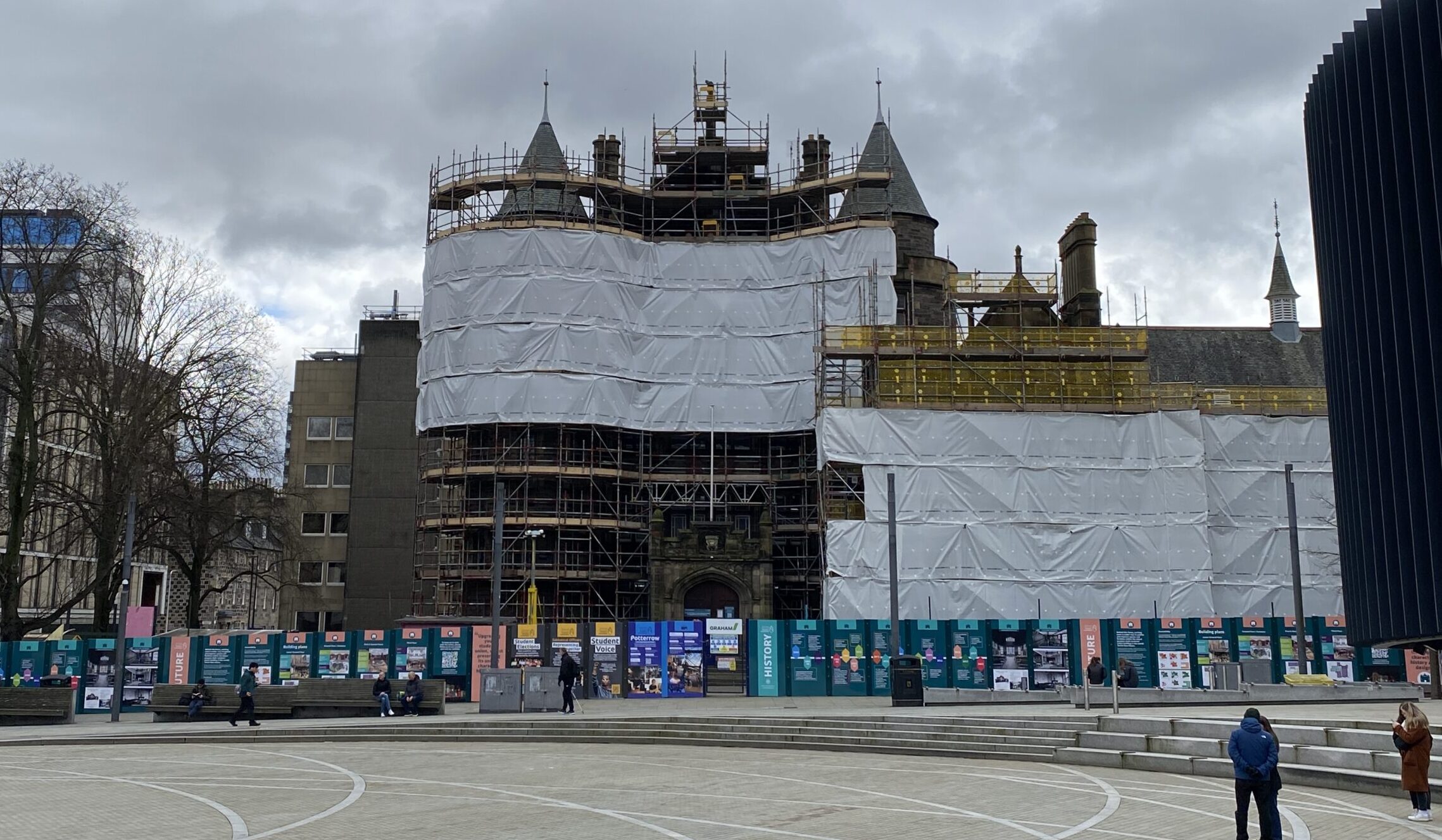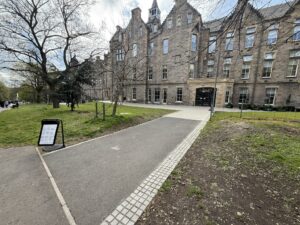Cannibalism, crime writing and staffing cuts at the University of Edinburgh

Over the past few years, the University of Edinburgh has been spending like drunken pirates on new buildings, land acquisitions, and facilities like the Edinburgh Future’s Institute and the refurbishment of Teviot Row House. The EFI is a billion-pound investment, and Teviot is under-going construction to increase accessibility and become a nicer wedding venue. But with all this spending, now the university chest of gold is looking less favourable than previous. And those gold coins don’t replenish themselves.

Side entrance to the Edinburgh Futures Institute through a high-end restaurant
I suppose when you get used to staring at £148 million in 2023 and now that pot of money sits at £84 million, I could see how this might make everyone nervous.
But, as of 31 July 2024, the net assets of the university stood at £3.1 billion—up from £2.7 billion—driven largely by the reversal of pension provisions. Last year, the university received a non-cash credit of £352 million due to the removal of the pension provision which was also met with rounds of strike action.
So, why has the university targeted staff and faculty with redundancies when they are seemingly awash in money? Their choice to cut staff, yet continue capital spending and maintain large reserves suggests a strategic choice: prioritizing estates and investments over academic research and integrity.
Unsurprising, faculty have started striking. As they should. The executive team’s spending spree is not their problem to fix, and to be fair — the university still enjoys a healthy £1.434 billion in income and a £25m surplus through their investment portfolio, assets, and grant income. The university has already slashed £24 million through voluntary staff redundancies, but they want to keep trimming to the tune of £92 million.
I’ve always taken patience to craft my appropriate thoughts on these matters, so here is a copy of the letter that I wrote to Principal Professor Peter Mathieson, and Professor Kim Graham, Provost – imploring them to stop their city-building project, and invest in their academic faculty.
An open letter
Dear Principal Professor Peter Mathieson; and Professor Kim Graham:
All around Edinburgh this week, statues of famous alumni will start sporting orange cones on their heads–a jaunty tradition of Welcome Week activities. This week, I’m preparing a lecture on 18th and 19th century crime fiction, and crafting slides about Robert Louis Stevenson, Arthur Conan Doyle, and the criminal operations in Edinburgh at the time. After all, I want to convey to students that the reason the detective figure was such a welcome agent of consolation was because thieves were rampant, justice was rarely delivered, and the accused often kept their spoils. On the rare chance that a suspect was apprehended, it was often the community that set the price and announced that the mystery was solved – or close enough.
But I can’t recall a time when £92 million mysteriously went missing from the university purse.
And yet, Edinburgh is slashing at academic salaries and scouring for that £92 million. A fair sum of money. How simple is it to acquire? Several rounds of redundancies, voluntary pay-outs, and cuts to staffing… it’s not as dramatic as bludgeoning victims in the streets like Mr Hyde was so famous for. But who gets to keep these spoils now? I suppose when you get used to staring at £148 million in 2023 (earnings before interest, tax, depreciation & amortization) and now that pot of money sits at £84 million, I could see how this might make the bean-counters a little weak at the knees. Spending like a drunken pirate does have its drawbacks.
But, as of 31 July 2024, the net assets of the university stood at £3.1 billion—up from £2.7 billion. Spending on land and buildings was up by £20m. Still, Edinburgh hasn’t moved the needle on the gender pay gap, and has actually widened the pay gap for staff with disabilities or ethnic backgrounds. Academia continues to be rife with unpaid labour in the form of peer reviews, lecture prep, and journal publications that result in zero income.
The university has already managed to cut £24 million through voluntary redundancies, and plans to reduce another £29 million. Is this a job well done? Not quite. Overspending is a dangerous gamble. So, here we are – Expenditures on facilities have skyrocketed. International dollars have dried up. Students from China are turning down offers. Lucrative American dollars are promising, but, they’ve got quite a few of their own problems these days. South Korea recently had to rescue their most senior officials after they were abducted by US immigration thugs in the State of Georgia. It makes one wonder, what are the consequences of these costly mistakes from today’s batch of President’s and CEO’s?
In dire times, Margaret Atwood reminds us that the early British explorers were quite fond of cannibalism, so perhaps if staff redundancies don’t produce the desired financial results, there can always be a feast of sorts. The Future’s Institute, which is lovely and rather spacious, might make for a good venue. After all, nothing is off the table.
Suffice to say, I am pleased with my doctoral research program but it’s not due to the kitchen facilities at 50 George Square. In my view, cutting academic salaries isn’t exactly justifiable against another fleet of pirate ships. And let’s be honest, what have academics really gained from all of this capital spending? New buildings that still don’t have air conditioning? Toilets that are indifferent to flushing? I’ve been fortunate to have significant access to my supervisory team who has generously gone beyond their academic duties to advance my research. After supporting their courses at the EFI as a teaching assistant, I’ve bestowed them with tea and biscuits as thank-you’s. I’ve witnessed the hours they work, and well – biscuits is the least I can do.
It’s no doubt that managing the university’s operating and capital budget can be precarious. Although, putting academic staff on the chopping block feels as ill-advised as McDonald’s taking hamburgers off the menu. It is kind of their main thing next to real estate investing. I’m sure you know the feeling. But let’s be reminded of what eager minds want. At Edinburgh, it’s access to the brightest researchers and the most generous academics. I recently met with a doctoral researcher from the University of Colorado who recounted how much he loathed his academic team, hated his PhD, and despised his supervisor who ignored his emails ninety percent of the time. He marveled at how I had two supervisors, and monthly meetings, and 1-1 support. He was in awe of the opportunities at Edinburgh. And I didn’t even mention the lack of air-conditioning or the haunted toilets. So why shrink what makes Edinburgh so valuable, I wonder? Why put more pressure on faculty when it’s not needed? How quickly can an institution go from revered to loathed? I implore you not to test it.
I’ve always found that strike action in Edinburgh feels like making tea in lukewarm water. It’s not strong enough, in my opinion. But what do I know? Canadians prefer to unleash the wolves. I don’t mind striking fear into the hearts of everyone around George Square but, Scotland really lacks the necessary apex predators for the job – they’re all bankers now. I would offer this: tread carefully in this situation. The Canadian government has announced significant new funding for postdocs. And with CA$140,000 in funding available per researcher, all things considered – I’d like to invest that money into a university that doesn’t enjoy eating their academics.
Warmest wishes,
Lexie Angelo
PhD Creative Writing
University of Edinburgh



